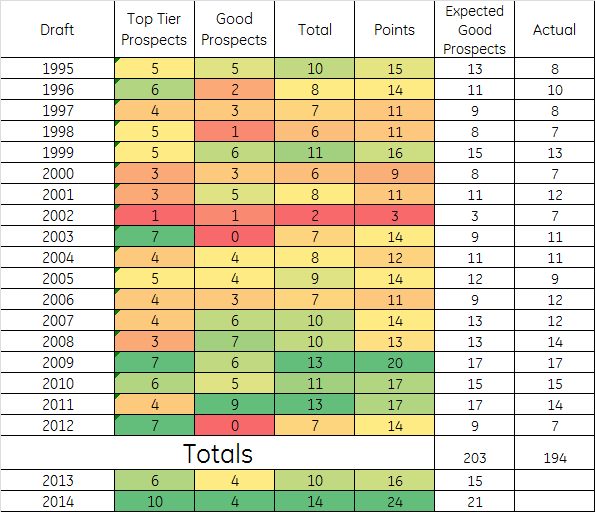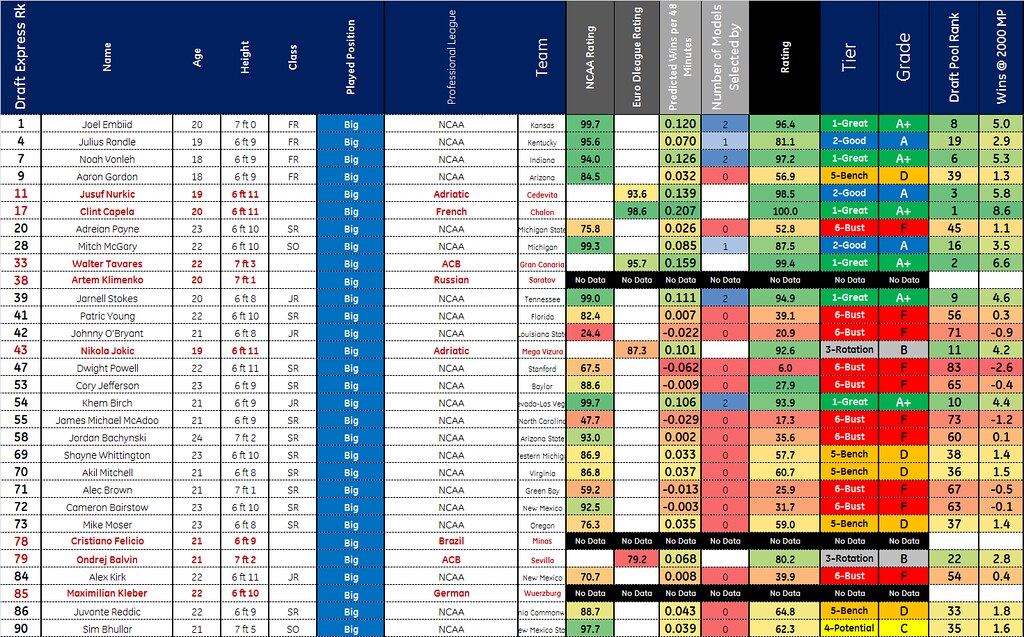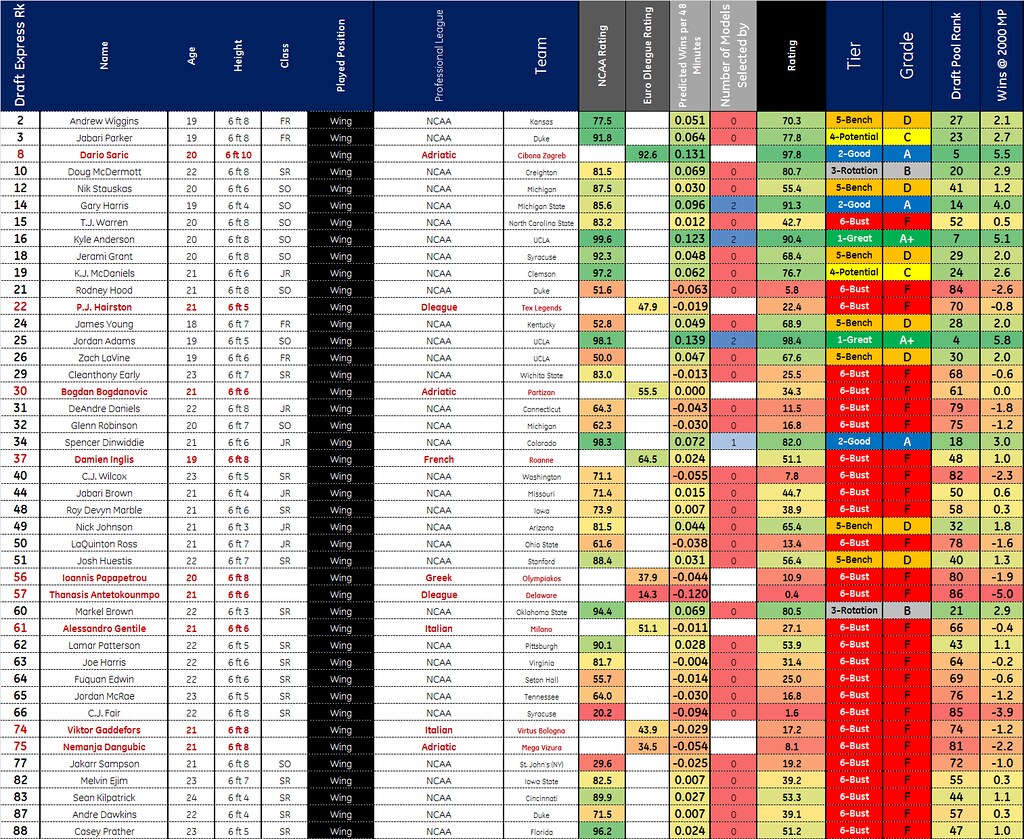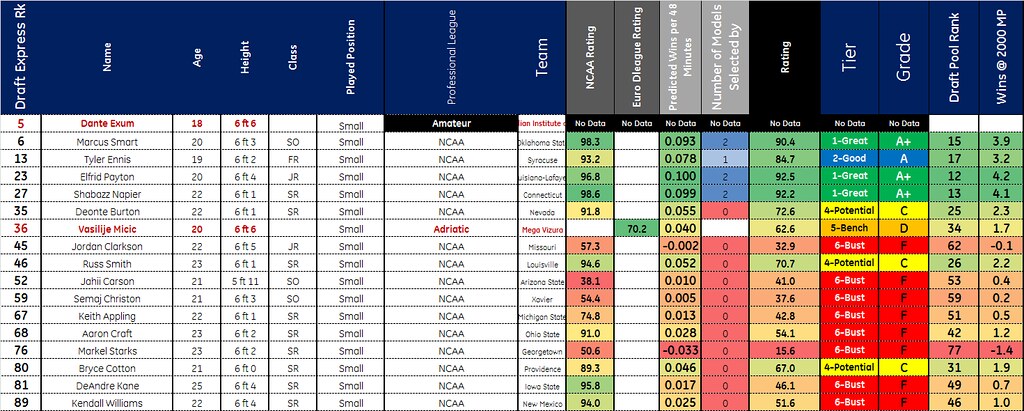(Editor Arturo's note: I screwed the data for two players. Kyle Anderson from UCLA and Spencer Dinwiddie from Colorado. I have fixed this as of 2AM EST on 6/26/14)
C-3PO: Sir, the possibility of successfully navigating an asteroid field is approximately three thousand, seven hundred twenty to one.
Han Solo: Never tell me the odds!
NCAA Interactive Player Ratings
NCAA Player Comparison Tool
You need to see the international and the Dleague players as well?
Euro/Dleague Interactive Player Ratings
With these tools in hand I can see and compare every prospect (with one notable exception) for the 2014 draft and I can make the most informed analysis possible.
It has performed at a very high level. For the full history you can go to:
- 2010 Draft Preview
- 2011 Draft Preview
- 2012 Draft Preview
- 2013 Draft Preview
- A full review (here) for a full breakdown
A neat little summary of how the model does is this:

As promised in a previous post, I will be updating this to include the 2010 class and doing a review on the 2013 class over the summer as it really deserves its own post.
European and DLeague prospects will be rated based on their actual professional competition numbers as projected to the NBA as shown in part two of the analysis. I will be doing this for all ranked prospects in the Draft Express database as well as any seniors that the draft model recommends be drafted. I did model every possible player but 1000+ prospects do not show well on a table. Feel free to request any player that you might like to see in the comments and I'll share their numbers.
There are four notable exceptions. Dante Exum (#5 in Draft Express), Artem Klimenko (#38), Cristiano Felicio (#78) and Maximilian Kleber (#85), where the data is either non-existent (Exum and Artem) or from a less than great league (Cristiano and Maximilian). For the last two it's not a real problem, as if you're interested, you can probably just invite them to summer league and your Dleague squad. Artem you can have for a second rounder but there are safer options that will be available. Exum is the big question mark. I'm going to link to the excellent piece Ryan Russillo did on Grantland. Here's the critical exchange for me:
Scout 3: I have no comparisons for him. None.
Unless you are some super-scout that saw him on some JV vocational team in Australia, you have only seen him live twice in like 14 months. The workouts give you nothing; we already know he’s big and an athlete. It’s a risk, but last time we saw him at the under-19 he dominated.
It’s all upside, but he’s never played against men. He has all the physical skills, great feel for the game, so that is where you start when you think about position in the NBA. We project PG will be his primary position.
To think he’s the third pick in the draft, and hasn’t played in 12 months … man, that is impressive.
Russillo: I swear we should just replace the word “upside” with the phrase “we don’t know how bad he could be.” Like everyone else, I’m not sure. He is a product of human nature; we don’t know enough about him, so we assume he is going to be good.
Caveat emptor. I wouldn't touch this kid with a ten foot pole. Way too much risk for the money, guards are a dime a dozen in the NBA,there are better and safer options in Europe.
If I'm going to risk it all on the mystery box, I'd prefer it to contain a freakishly athletic big man.
Let's get to the numbers. We start with all the NCAA ranked prospects and seniors rated as picks by our model. You'll note that unranked Seniors will show up highlighted in black. I've also put in the net player rating for the 2013-14 NCAA season as per part 1, this is to give you an idea of how productive the players actually were in college.

We have 18 two star prospects (i.e selected by the two models) and 10 one star prospect (selected by only one) amongst the NCAA players. Of these, 10 and 4 are likely to see the court in an NBA game. How does this compare historically?

That would prospectively make this the best draft in our numbers. It gets even more fun when we add in all the international prospects.
Here comes the full draft table.Please note that I've divided prospects into 6 categories:
- 1-Great: Zero red flags. Models love him. Statistics want to date him.
- 2-Good: One red flag. Could be less than stellar performance in league. Could be one model passing on him. Could be too little minutes.
- 3-Rotation: 2 red flags but with some indicator of good performance.
- 4-Potential: 3 red flags but with some indicator of good performance.
- 5- Bench: No indicators of good performance but a projection that says he'll be an effective bench player. See Young, James.
- 6- Bust: Zero indication of even mediocre performance. If your team is drafting one of these player's , vaya con Dios my friend. See Hairston, P.J.

A nice graphical way to view this follows.

Let's break it down by position so I can then give my two cents. We start, as you always should in the draft, with the bigs.

- Capela is easily the best big prospect and I'd have him number 1 on my draft board. The knocks on him (shooting, turnovers) are things that will go away with proper training. You can't teach tall, handle,athleticism, motor or ball hawking and he's got those in spades and he's already using them to produce at 20. If the Celtics pass with him, I may need to break up with Danny Ainge.
- Tavares and Nurkic both look to be great value as well. I'd avoid drafting the rest of the euro bigs.
- Embiid looks every bit the franchise changing big if he can stay healthy and on the board. You also have to play the long game with him and rehabilitate him properly. I'd need a detailed medical report but I'd definitely draft him number 1 if I were Cleveland. I expect he'll go with the three to Philly but we will see.
- Vonleh, Stokes and Birch are all two model recommendation bigs with sparkling NCAA production. Good value picks at their slots.
- Single recommendation players are Mitch McGary and Randle. I'd recommend Randle with zero issues. McGary has had some medical issues and a low minute sample. Again, consult with your medical expert.
- The players to avoid are: Aaron Gordon (short, young, unproductive), Adreian Payne, Patric Young, McAdoo, O'Bryant,Powell and Cory Jefferson (older and unproductive).
Let's do the wings next:

- Kyle Anderson's numbers are killer across the board and he rates higher than his numbers given that he put them up on a loaded UCLA team. Definite must draft candidate and a great value at any pick.
- Jordan Adams is loved by the models and his stats are stellar. He's also favored by the fact that he played on a very good UCLA team as that is generally an indicator that the model may be undervaluing him. Great late first round value.
- Dario Saric is another easy recommendation. Good size, good numbers and a decently large sample size in a competitive pro league. The only thing that stops it from being higher is I wish his production was a bit higher.
- Gary Harris is the other two model recommendation for the wings. His numbers in the NCAA were a bit lower which is why I have him as a second tier recommendation.
- Doug Mc Dermott does not quite get a full recommendation from the model.
- Spencer Dinwiddie is porjected as an early second round steal.
- Are there ever some landmines here. Jabari Parker looks to have some potential but he's severely overvalued based on his numbers in the NCAA. The numbers suggest he will be a good NBA player eventually but right now? Not so much. The numbers are less kind to Andrew Wiggins. He was not great in the NCAA. Spending a lottery pick on him is downright irresponsible. I think both these guys will be NBA level talent but not for the team that drafts them.
- Some other to note: Nick Staukas (just ok), TJ Warren (bad across the board), Jerami Grant ,K.J. McDaniels, James Young and Zach Levine (enough potential to warrant a Dleague shot but not a lottery pick).
- P.J Hairston is terrible and if the Celtics draft him, I will become a Spurs fan full time.
- Every other wing is just no.
Let's end with the smalls:

- Payton, Napier and Smart are one, two and three in some order. The models love all three and their numbers are very similar. I'd give the edge to Payton probably on size and that he's going to be relatively inexpensive.
- Tyler Ennis is good but young. The model docks him for his youth. He might not be that good on his rookie contract.
- All the other smalls are so/so and I wouldn't spend any draft capital on them. You can find and sign that level of player on the street or in Europe and develop them in the Dleague (remember Jeremy Lin).
- We talked about Dante Exum before. Zero data on him. If you draft him, you better be prepared for something like the Otto Porter, Darko, or Anthony Bennett experiences. I would not take him. (Update: I ran the numbers from Exum at the Under 17 and Under 19 World Championships. I get a 6.28 Win Score per 40 in a very small sample size of 487 minutes. If those numbers were taken as similar to NCAA numbers,Dante would rate as the fifth small behind Ennis and be recommended by one of the Models. The implication seems to be that he is not quite ready and you might not get full value for the pick. I would still recommend a pass. Better options are available.)
With that we come to a close. I swear I've put a month's worth of work into this post.
Oh, there is one more thing. Here is everything in a worksheet so you can play with it and follow along during the draft.
Cleveland you are officially on the clock now.
-Arturo